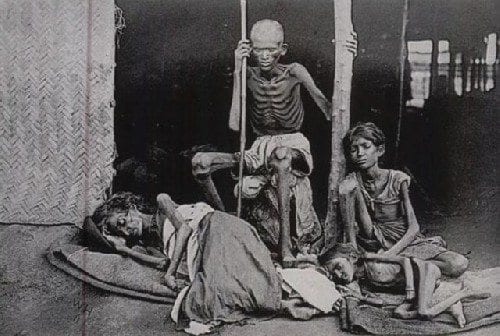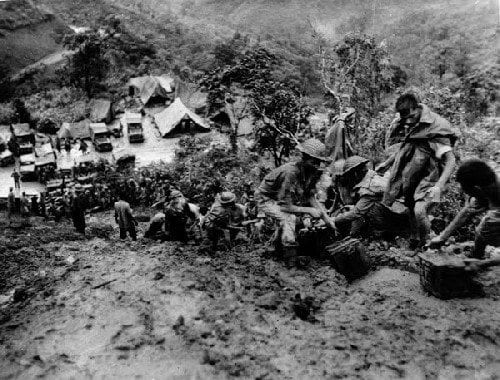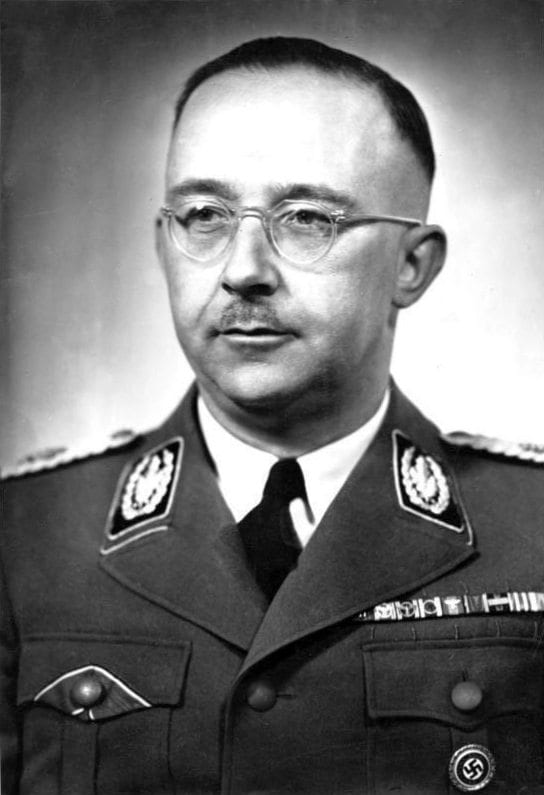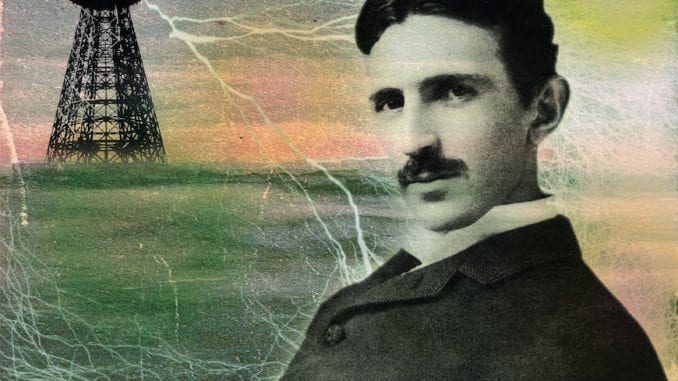3 million people died in a Winston Churchill engineered famine. While Britain stockpiled food, even importing tens of thousands of pounds of rice from India, Churchill, knowing their dire situation, refused to send any of the food to India, choosing to stockpile until the price went up. He even chose to bypass India on food shipments from Australia, a previous stop for the ships.
The sweeping famine of Bengal occurred simultaneously with the German-inflicted genocide in Europe. While Churchill formulated policies to free Britain from the clutches of Hitler’s superior race propaganda, he turned his back towards the natives of India, who were turning into living skeletons.
It was the imperial policies formed under Churchill that led to the death of over 3 million people in Bengal which comprised the current West Bengal, Odhisha, Bihar and Bangladesh. True, the crop of 1942 turned out bad due to a cyclone, but it was the arrogance of the PM that pushed so many people towards death. India exported more than 70,000 tonnes of rice between January and July 1943, even as the famine set in. This amount was enough to sustain nearly 4 lakh people for a year.

Besides, the Quit India Movement launched in 1942, irked Churchill, and as a revenge-seeking measure, he chose to overlook the catastrophe in Bengal. He rather preferred sending rice and wheat to the Imperial Indian Army fighting on behalf of the British Empire in World War II.
Meanwhile famine-struck people streamed into Calcutta, begging the relatively well-off section for the starchy water of boiled rice. Churchill casually diverted international medical and food supplies to the well-supplied soldiers stationed in Europe, which was actually meant for the starved.

When Burma (now Myanmar) was defeated, England got nervous that India could be the next target. Churchill pushed the Denial Policy to deliberately keep food stocks low in Bengal. The logic was simple; if the Japanese forces arrived, they would be hit by lack of food. Fearing invasion, the water route was made redundant too by destroying boats. So people from Bengal who were dependent on sea businesses, had nothing to fall back upon, not even a possible escape route to beat starvation.
 While shrunken people breathed their last on the streets of Calcutta, all that Churchill did was sneer and scoff. He infamously said, “Famine or no famine, Indians will breed like rabbits.” He was happy that nature was “merrily” downsizing the Indian population.
While shrunken people breathed their last on the streets of Calcutta, all that Churchill did was sneer and scoff. He infamously said, “Famine or no famine, Indians will breed like rabbits.” He was happy that nature was “merrily” downsizing the Indian population.
He cared two hoots about the thousands of starving people, who had taken to eating grass and vines to fend off hunger. Churchill shamelessly professed his hatred, “I hate Indians. They are a beastly people with a beastly religion.” Their main offence: they were not white-skinned.
The government led by Churchill turned down an urgent request from Leopold Amery (the Indian secretary of state) and Archibald Wavell (the Viceroy of India) to stop exporting food from Bengal, as thousands were dying of hunger. Churchill retorted, “Then why hasn’t Gandhi died yet?”

had initiated the Quit India Movement in 1942, and it was gaining momentum. For Churchill, who believed the natives (of India) should be grateful for being under the Imperial Crown, it was big slap across his face. This outburst was a perverse manifestation of revenge.
When British officers pleaded Churchill to mitigate the food crisis, he blamed shortage of ships to bring food into Bengal. Of course he lied through his teeth; ships carrying wheat from Australia would pass by India and sail to Europe. As imports thinned, inflation touched the sky. People who were already reeling under starvation, could not afford the inflation.
The famine ended at the end of 1943, when survivors harvested their rice crop. Author Madhusree Mukerjee, who met a handful of Bengal Famine survivors, wrote in her book Churchill’s Secret War: “Parents dumped their starving children into rivers and wells. Many took their lives by throwing themselves in front of trains… People were too weak even to cremate their loved ones.”
This was what prosperous Bengal was reduced too by the British Raj: a state of ghoulish-looking deprived people, dying on the streets like stray animals.
From <http://www.liveleak.com/view?i=b8b_1458265460>
The BBC adds this in a 2010 article titled ‘How Churchill starved India’
It is 1943, the peak of the Second World War. The place is London. The British War Cabinet is holding meetings on a famine sweeping its troubled colony, India. Millions of natives mainly in eastern Bengal, are starving. Leopold Amery, secretary of state for India, and Field Marshal Sir Archibald Wavell, soon to be appointed the new viceroy of India, are deliberating how to ship more food to the colony. But the irascible Prime Minister Winston Churchill is coming in their way.
“Apparently it is more important to save the Greeks and liberated countries than the Indians and there is reluctance either to provide shipping or to reduce stocks in this country,” writes Sir Wavell in his account of the meetings. Mr Amery is more direct. “Winston may be right in saying that the starvation of anyhow under-fed Bengalis is less serious than sturdy Greeks, but he makes no sufficient allowance for the sense of Empire responsibility in this country,” he writes.
Some three million Indians died in the famine of 1943. The majority of the deaths were in Bengal. In a shocking new book, Churchill’s Secret War, journalist Madhusree Mukherjee blames Mr Churchill’s policies for being largely responsible for one of the worst famines in India’s history. It is a gripping and scholarly investigation into what must count as one of the most shameful chapters in the history of the Empire.
The scarcity, Mukherjee writes, was caused by large-scale exports of food from India for use in the war theatres and consumption in Britain – India exported more than 70,000 tons of rice between January and July 1943, even as the famine set in. This would have kept nearly 400,000 people alive for a full year. Mr Churchill turned down fervent pleas to export food to India citing a shortage of ships – this when shiploads of Australian wheat, for example, would pass by India to be stored for future consumption in Europe. As imports dropped, prices shot up and hoarders made a killing. Mr Churchill also pushed a scorched earth policy – which went by the sinister name of Denial Policy – in coastal Bengal where the colonizers feared the Japanese would land. So authorities removed boats (the lifeline of the region) and the police destroyed and seized rice stocks.
Mukherjee tracks down some of the survivors of the famine and paints a chilling tale of the effects of hunger and deprivation. Parents dumped their starving children into rivers and wells. Many took their lives by throwing themselves in front of trains. Starving people begged for the starchy water in which rice had been boiled. Children ate leaves and vines, yam stems and grass. People were too weak even to cremate their loved ones. “No one had the strength to perform rites,” a survivor tells Mukherjee. Dogs and jackals feasted on piles of dead bodies in Bengal’s villages. The ones who got away were men who migrated to Calcutta for jobs and women who turned to prostitution to feed their families. “Mothers had turned into murderers, village belles into whores, fathers into traffickers of daughters,” writes Mukherjee.
The famine ended at the end of the year when survivors harvested their rice crop. The first shipments of barley and wheat reached those in need only in November, by which time tens of thousands had already perished. Throughout the autumn of 1943, the United Kingdom’s food and raw materials stockpile for its 47 million people – 14 million fewer than that of Bengal – swelled to 18.5m tons.
In the end, Mukherjee writes eloquently, it was “not so much racism as the imbalance of power inherent in the social Darwinian pyramid that explains why famine could be tolerated in India while bread rationing was regarded as an intolerable deprivation in wartime Britain”. For colonial apologists, the book is essential reading. It is a terrifying account of how colonial rule is direly exploitative and, in this case, made worse by a man who made no bones of his contempt for India and its people.



